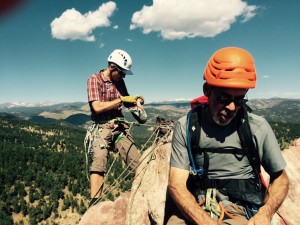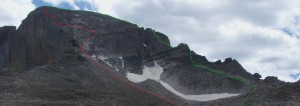AMGA Guide Rob Coppolillo Reviews the Mammut 9.5 Infinity Dry Rope
First off, full disclosure: I’ve been using Mammut ropes for 20 years, by choice and quite happily—and as long as I’m spilling the beans, Mammut provided this rope for free (to test, of course!). So, two strikes against me in terms of objectivity—but, I must say, I summoned my best journalistic integrity to give the Infinity Dry 9.5mm rope a fair and honest review.

Rigging the rappel atop the First Flatiron, Boulder, Colorado, with the Mammut 9.5 Infinity Dry rope. Photo: Rob Coppolillo
I’ve owned just about every Mammut single-rated rope available, from their svelte 8.7 mm Serenity to a 10 mm workhorse I still deploy on toprope days. I was a devoted Mammut guy until a few years ago when SCARPA began distributing Edelrid in North America. Suddenly, I had occasion to sample the German-made Edelrid products (they’re great!). And as I progressed through the guide program, I had occasion to use several Sterling ropes, as well.
Even having tested the competitors’ products, I still rank Mammut’s ropes at the top of the heap. Enter the 9.5 Infinity Dry: Mammut’s Infinity falls somewhere between a “skinny” cord—like many of the 8.9/9.0/9.1mm models offered by Mammut and other manufacturers—and “fatter” ropes like 9.8mm models used when working projects and toprope-guiding with groups. Having owned and used an Infinity the past couple years, I’d let it lapse into a bit of a “purgatory” in terms of my uses for it, considering it a thicker, heavier rope.
Upon receiving this latest iteration of it, though, I revisited its technical properties and was surprised to find it’s a single gram heavier per meter than Mammut’s much thinner 9.2 mm Revelation. Huh? The Infinity feels much heavier than its skinnier sibling, though it’s obviously not—a mere 60 g for a 60 m model.
So what gives? Why does the Infinity feel like a more traditional rope, instead of the lighter, modern cord that it is? A couple emails later I’d queried a few friends online about their use of Mammut ropes, and a smarter and stronger colleague wrote to remind me that the Infinity is barely heavier than the 9.2, but wears far, far longer. Another buddy, who spends dozens of days a year short-roping and climbing on the Grand Teton, explained they were getting much better wear out of the 9.5 Infinity than the 9.2 Revelation.
Turns out the Revelation has less of its weight devoted to sheath (36 percent) than the Infinity (40 percent). A-ha, now we’re getting somewhere. The Infinity has a bit more sheath to give toward durability, while the 9.2 mm Revelation devotes its structure to core and handling. When scoring a rope for free, one can go for handling, but I expect for the vast majority of us purchasing ropes—even at a discount—will opt for the additional gram/meter of the Infinity and appreciate the enhanced durability, while sacrificing just a bit of handling.
I guided probably 25 days on this latest Infinity, in and around Boulder, Colorado. I short-roped the East Slabs descent in Eldo, took the Infinity up the Keyhole Ridge and down the Cables Route on Longs Peak in Rocky Mountain National Park, clipped bolts in BoCan, and everything in between. I looped horns, lowered over rock, rappelled slabby stuff, short-pitched, etc. In my head, the Infinity felt a bit more cumbersome than the Revelation, but I reminded myself that the weights are practically identical. I found myself wanting to leave part of the Infinity in my pack when using the rope short—that extra 0.3 mm can’t make that much of a difference, eh?!

The North Face of Longs Peak, Rocky Mountain National Park, Colorado, where AMGA guide Rob Coppolillo field-tested the Mammut 9.5 Infinity Dry rope. The ascent route, in green, is Keyhole Ridge; the descent route, in red, is the North Face (Cables Route). Photo: Rob Coppolillo
All told, I think the Infinity simply feels much different than the skinnier, more performance-driven cords Mammut crafts, but ultimately, as a day-in, day-out work rope…it’s probably the better call.
A previous Infinity I owned was bi-pattern; this latest Infinity was the solid bright-yellow version. I think spending the additional $30-or-so for bi-pattern is probably worth it (from a safety perspective), but consider, too, that it’s far easier to find the middle of the rope when it sports the black marks, rather than the subtle bi-pattern change. That said, you can always mark the middle of your bi-pattern ropes with a laundry pen, if you’re really into that.
I’d call the Infinity’s strong points its quality (Swiss made), its durability, and its all-around capability. If forced to name its shortcomings, I’d say it doesn’t handle as well as its slightly skinnier counterparts. This is an unfair comparison, though—asking a 9.5 to handle as well as a 9.2 or 8.7—but what I mean is that if you’re accustomed to coiling and handling a 9.0 mm rope, the Infinity might feel thick when you’re using it.
The reality, though, is that we’re all running a business to some degree. Guiding on your own or working for a big guide service, we need to consider cost and longevity—and when those factors are tallied, I’m not sure you can find a better do-it-all cord than Mammut’s 9.5 Infinity Dry.
Specs
Diameter: 9.5 mm
Weight: 58 g/m (60 m rope—3480 g/7.6 lbs)
Impact force: 8.7 kN
UIAA falls: 7–8
Static elongation: 6.8 percent
Dynamic elongation: 30 percent
Cost: $180–299 retail, depending on site/shop












